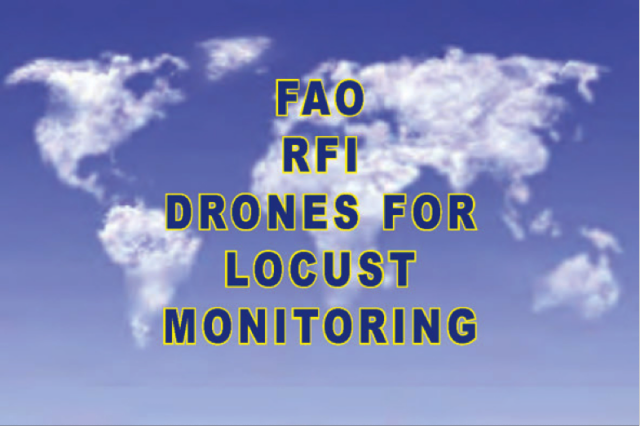 Subsequent to his presentation at the RPAS CivOps 2016 conference, Keith Cressman, Food & Agriculture Organization (FOA) of the United Nations, has requested me to inform the international RPAS community of the current FAO Request for Information (RFI).
Subsequent to his presentation at the RPAS CivOps 2016 conference, Keith Cressman, Food & Agriculture Organization (FOA) of the United Nations, has requested me to inform the international RPAS community of the current FAO Request for Information (RFI).
FAO is looking to obtain preliminary information on the availability of potential vendors to provide solutions enabling FAO, within the context of Desert Locust early warning & preventive control systems, to improve its monitoring activities through the use of fixed and rotary wing ‘drones’.
The purpose of this RFI is to obtain preliminary information on the availability of potential vendors to provide solutions enabling FAO, within the context on Desert Locust early warning and preventive control systems, to better its monitoring activities through the use of fixed and rotary wing drones.
Vast areas of remote desert which include some of the world’s poorest countries are regularly monitored for Desert Locust by national ground teams in 4WD vehicles. These areas have no mobile or internet coverage and are several days drive or more from the National Locust Centers. Although satellite-based estimates of rainfall and green vegetation are utilized to reduce and prioritize these large and potentially suitable areas, imagery suffer from omission errors and are often not available in time. Aerial surveys are usually not possible due to high costs and unavailable aircrafts. Consequently, there is a need to supplement these tools with additional technologies to guide ground teams to green vegetation and locust infestations.
The use of fixed and rotary wing drones, could be a potential means of improving Desert Locust monitoring, early warning and rapid control, and reducing the costs of survey and control.
The information gathered from this RFI will be used by FAO to confirm or infirm that assumption and to determine the feasibility, scope, timeframe and resources required by FAO.
FAO is thus looking for solutions to improve the Desert Locust monitoring, early warning and rapid control system and to reduce the costs of survey and control.
RFI Reference: FAO/RFI/Drones-2016
See complete RFI: https://www.ungm.org/Public/Notice/51831
See additional documents at: https://www.ungm.org/Public/Notice/51831
For additional information contact: CSAP-Contracts-Group@fao.org
Deadline: 15 January 2017
